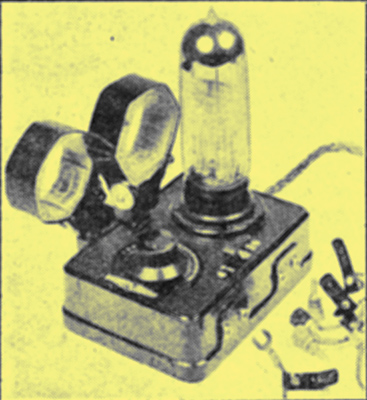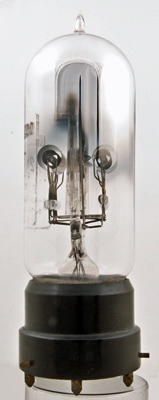|

The Loewe receiver.
A leaflet from the makers: in their ambition to supply radio sets the price of which will be within the reach of everybody, the Loewe Radio Company, Ltd, have just reduced the price of their 'local' receiver to three guineas. By speeding up production in their Tottenham factory and reducing prices it has been possible to give the public the benefit of this reduction and an enormous demand is expected.
The new price brings what is virtually a three-valve receiver within the reach of all those who have previously only been able to afford a crystal set. The cautious purchaser will naturally wonder what will happen if one of these three-in-one valves burnt out. How would he be placed as regard replacements.
The Company announce that ample provision made for this, and provided the glass bulb is intact and the internal structure not mechanically destroyed, any multiple valve can be repaired after the filament has been burnt out.
The cost of this repair has been fixed at 16s. 6d. (including royalty), which is less than the replacement price of a super-power valve. Thus the cost of the valve included in the price of the set is only an initial expense, no further new valves being necessary in ordinary circumstances.

The Loewe 2HF. Not used in this receiver.
Unique receiver.
One of the most ingenious of Wireless inventions is the Loewe multiple valve which is now manufactured in England. This valve, which is really three valves in one, contains within its glass bulb all the components necessary for a detector and two stages of resistance-coupled low-frequency amplification, namely, three valves, three anode resistances, two grid leaks, and two coupling condensers! The valve itself is a miracle of ingenuity and when fitted with the necessary tuning apparatus a loud speaker set can be compressed into a minimum of space.
The illustration shows the complete Loewe loud-speaker set with its battery cable and coils in place. Tuning is carried out by means of the variable condenser knob, whilst variable reaction is obtainable by means of two coils in a two-coil holder. On test the set gave very good and pure results, adequate strength for loud-speaker reproduction being obtained on the outside aerial from 2LO and 5GB at Wimbledon. The tone is very good and pure and the whole set sells for a remarkably low price.
A point to be noted is that the set works quite well on the 90 Volt battery, and although, of course, two resistance stages do not, give the same magnification as a resistance and a transformer stage, the set functions admirably as a local receiver with the alternative station available when required. By changing coils the set will work quite well on 5XX. If one filament should burn out, the valve can be repaired at a cost. appreciably lower than that of a new valve, and the total high-tension consumption of the set is quite low. It can certainly be recommended for the purpose for which it is designed.
|